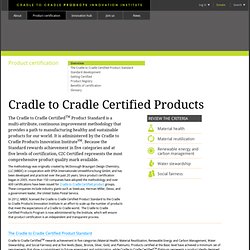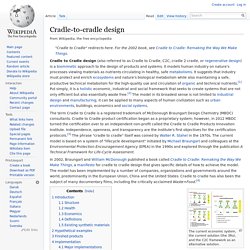

Recycling Mobile Phones Worldwide. Cradle To Cradle Products Innovation Institute. The Cradle to Cradle CertifiedTM Product Standard is a multi-attribute, continuous improvement methodology that provides a path to manufacturing healthy and sustainable products for our world.

It is administered by the Cradle to Cradle Products Innovation InstituteSM. Because the Standard rewards achievement in five categories and at five levels of certification, C2C Certified represents the most comprehensive product quality mark available. The methodology was originally created by McDonough Braungart Design Chemistry, LLC (MBDC) in cooperation with EPEA Internationale Umweltforschung GmbH, and has been developed and practiced over the past 20 years. Since product certification began in 2005, more than 150 companies have adopted the methodology and over 400 certifications have been issued for Cradle to Cradle Certified product groups.
These companies include industry giants such as Steelcase, Herman Miller, Desso, and a government leader, the United States Postal Service. Glossary. The Great Recovery - Redesigning the future. Cradle to Cradle Network. Cleaner Indoor Air with Desso Carpet. Keeping our tootsies pampered during midnight trips to the bathroom is a job any carpet can handle.

But clean the air of all that icky stuff floating around that we know is there but glad we can’t see? According to Dutch carpet manufacturer Desso, their new carpet line AirMaster can greatly reduce the concentration of that microscopic particulate matter to improve indoor air quality eight times better than hardwood floors. Tall claim, but they have several independent studies backing it up. Turns out, carpeting as a floor covering is a pretty effective air cleaner. Studies are now showing the harmful effects of airborne particulates are lowered when carpet is used in the home instead of wood or other hard surfaces. But according to The German Allergy and Asthma Association, particulate matter settles on top of hard surfaces, where it gets kicked back up into circulation around our house. Unfortunately for us, Desso residential carpet products are not yet available in the U.S. Nike Considered. Nike Considered boot Nike Considered[1] is a sustainable line of shoes introduced by Nike, Inc., a major American supplier of athletic shoes, apparel and sports equipment.

Nike Considered was developed by Richard Clarke, Tinker Hatfield, Steve McDonald, Mike Aveni & Andreas Harlow working with the Innovation Kitchen, located on Nike's 175-acre (0.71 km2) headquarters campus in Beaverton, Oregon. Brad Long & Steven Ploem commercialized the footwear designs for mass production.Nike Considered grew out of Nike’s commitments to design innovation and to sustainability. The designers pulled from the best ideas, both inside and outside the company, with the intent of reinventing footwear design. It also grew out of conversations with consumers who were increasingly asking for more sustainable products. Nike Considered shoes were awarded product Design Excellence awards in 2006 & 2007 by ID Magazine. Features[edit] Eliminating waste and toxic materials[edit] Using less energy[edit] Promotion[edit] Homepage of Prof.dr. Michael Braungart. Green Economy, Sustainable, Nachhaltigkeit, CSR - nächster Schritt ganzheitliche Innovationen.
Nie mehr Müll - Leben ohne Abfall. Michael Braungart. Prof. Dr. Braungart über sein "Cradle to cradle"-Konzept auf der Utopia Konferenz. C2C. Cradle-to-cradle design. Cradle to Cradle design (also referred to as Cradle to Cradle, C2C, cradle 2 cradle, or regenerative design) is a biomimetic approach to the design of products and systems.

It models human industry on nature's processes viewing materials as nutrients circulating in healthy, safe metabolisms. It suggests that industry must protect and enrich ecosystems and nature's biological metabolism while also maintaining a safe, productive technical metabolism for the high-quality use and circulation of organic and technical nutrients.[1] Put simply, it is a holistic economic, industrial and social framework that seeks to create systems that are not only efficient but also essentially waste free.[2] The model in its broadest sense is not limited to industrial design and manufacturing; it can be applied to many aspects of human civilization such as urban environments, buildings, economics and social systems.
Introduction[edit] Cradle To Cradle Products Innovation Institute. The program guides continual improvement towards products that are: - made with materials that are safe for humans and the environment - designed so all ingredients can be reused safely by nature or industry - assembled and manufactured with renewable, non polluting energy - made in ways that protect and enrich water supplies, and - made in ways that advance social and environmental justice What makes your product "sustainable"?

How do important audiences know for sure? Certified Cradle to Cradle is rigorous. The Cradle to Cradle CertifiedTM Products Program is comprehensive and rigorous. It requires a paradigm shift in thinking about how a product is designed, what it contains, how it is made, and where it goes after use. As a guidance system for product designers and manufactuers, the program leads to the creation of innovative products that redefine quality and beauty. Products are analyzed by assessors that have been accredited by the Institute. Cradle to Cradle.